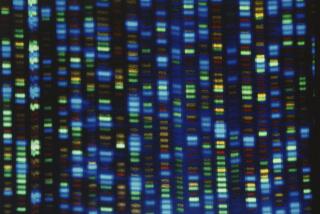PERSPECTIVE ON MEDICINE : Lovely Promises, Down the Road : The allure of genetic research is powerful, but we shouldn’t fool ourselves about when it will effect cures.
The announcements come now by the dozen--a new gene for a human disease has been discovered, isolated or cloned. Huntington’s chorea. Duchenne muscular dystrophy. Cystic fibrosis. A gene that predisposes to or protects from tumors of the bowel or some other form of cancer. The gene thought to be responsible for the degenerative condition ALS (Lou Gehrig’s disease). Genes for common diseases, genes for rare ones. The revolution that began scarcely 40 years ago with the discovery of the structure of DNA continues to generate astounding insights into human ailments that are, or may be, inherited.
But a cynic asks: Where are the cures?
If the genes and DNA can be isolated, spliced and manipulated with such apparent ease, why is there no gene-based therapy for Huntington’s, for muscular dystrophy, for cystic fibrosis? And what about cancer?
In modern medicine, diagnostic and analytical techniques always develop in advance of therapeutic tools. The “molecular biology revolution” is not the only example of this truth. The advent of computerized tomographic and magnetic resonance image scanning represented giant strides in our ability to find cancers in the brain and the rest of the body--cancers for which relatively little can often be done once they are discovered.
It is almost certain that most hereditary conditions will yield to diagnosis using genetic probes long before treatments for them using similar technology become available. Thus, consider the ethical dilemma of being able to accurately project a future that holds ALS or Alzheimer’s disease for a child, even a fetus.
There is also this caveat to molecular genetic work: Even when the gene that causes an illness is localized to a very small piece of a chromosome, tall hurdles must often be jumped before the responsible fragment of DNA is isolated, allowing for insights that explain the mechanism for the disease. Gene abnormalities can be very small or very large, extending over much of a chromosome. Only when it is isolated can the tough job of playing with the gene, eliminating or modifying it, begin. The location of the Huntington’s gene has been known for almost 10 years, yet a full understanding of the complex molecular abnormality that produces the disease still seems remote.
One must also accept that many diseases are simply not inherited, or at least not simply inherited. If a tendency to develop a condition is inherited, there are sometimes environmental or toxic factors superimposed on that tendency so forcefully that they become major players themselves. Molecular geneticists, alas, sometimes fail to accept the complexity of non-genetic factors that lead to disease.
Most cancerous growths fall into the “non-inherited” category, though there are strong familial tendencies to develop some forms. Degenerative neurologic disorders are among the best examples of non-inherited conditions. The location of genes for familial Alzheimer’s disease has been found, yet the majority of cases of this common and tragic ailment occur sporadically. The same is true of ALS. Geneticists claim that understanding the familial forms of an illness will automatically provide insights into the non-familial or sporadic variants.
In the meantime, some funding agencies provide research dollars overwhelmingly, almost exclusively, to those who concentrate their efforts on the molecular genetic basis of disease. Medical school administrators become misty-eyed at the sound of the words “cloning DNA.” There is a widespread acceptance of the notion that clinically based or applied research is inferior to basic molecular work, despite clear evidence that clinically applied research has done much to alleviate human suffering. Molecular biology holds out a tantalizing promise of success, but clinical research provides more immediate results.
Even the Nobel committee seems to have sensed this. Traditionally known for rewarding basic, highly theoretical studies, it recently conferred its medicine/physiology prize on the two men who developed and refined bone marrow and kidney transplantation. Yet these two individuals would likely be the first to grant that their work was possible in large part because of a giant push in the basic arena to develop anti-rejection drugs and techniques to “engineer” human cells using molecular tools.
As the synergy between clinical and basic molecular research evolves, medical practitioners simply need reminding that their most valuable tools may well be the ones still cherished by hopeful patients: caring, compassion and dedication to the art and craft of humanitarian healing rather than the power of genes.






